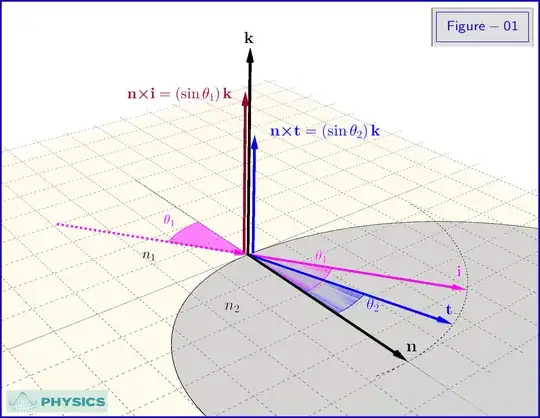
Notation in Figure-01 :
\begin{align}
n_1,n_2 & \boldsymbol{=} \texttt{indices of refraction}
\nonumber\\
\theta_1,\theta_2 & \boldsymbol{=} \texttt{angles of incidence and transmission}
\nonumber\\
\mathbf i & \boldsymbol{=} \texttt{unit vector on incident ray}
\nonumber\\
\mathbf t & \boldsymbol{=} \texttt{unit vector on transmitted ray}
\nonumber\\
\mathbf n & \boldsymbol{=} \texttt{unit vector normal to the interface of the two media}
\nonumber\\
\mathbf k & \boldsymbol{=} \texttt{unit vector normal to the plane of }\mathbf i,\mathbf t,\mathbf n
\nonumber
\end{align}
Snell's law is expressed as
\begin{equation}
n_1\sin\theta_1\boldsymbol{=}n_2\sin\theta_2
\tag{01}\label{01}
\end{equation}
or
\begin{equation}
\sin\theta_2\boldsymbol{=}\mu\sin\theta_1\,,\qquad \mu\boldsymbol{=}\dfrac{n_1}{n_2}
\tag{02}\label{02}
\end{equation}
so
\begin{equation}
\underbrace{\left(\sin\theta_2\right)\mathbf k}_{\left(\mathbf n\boldsymbol{\times}\mathbf t\right)}\boldsymbol{=}\mu\underbrace{\left[\left(\sin\theta_1\right)\mathbf k\right]}_{\left(\mathbf n\boldsymbol{\times}\mathbf i\right)}
\tag{03}\label{03}
\end{equation}
that is Snell's law in vector form
\begin{equation}
\left(\mathbf n\boldsymbol{\times}\mathbf t\right)\boldsymbol{=}\mu\left(\mathbf n\boldsymbol{\times}\mathbf i\right)
\tag{04}\label{04}
\end{equation}
